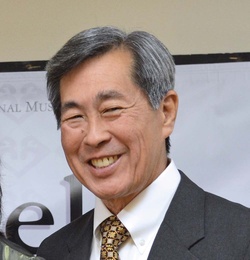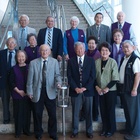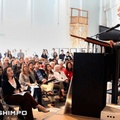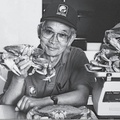Over the years, Ken Hamamura has assumed various roles at the Japanese American National Museum. As a donor, staff member, and volunteer, he learned the importance of preserving and sharing our stories and artifacts to create a legacy for future generations.
Inspired by the Museum’s ongoing mission, Ken started to focus on his family history and hopes to build an enduring legacy for his daughter and grandsons. For some time now, the retired Sansei with Kibei parents has been researching and documenting his family’s history, delving into archived records, collecting photographs, and traveling to places that are meaningful to the family’s past.
He learned, for example, that in 1886 at the age of 21, his grandfather left Hiroshima for Hawaii under a three-year contract to work on a sugar plantation in Onomea, just north of Hilo, on the Big Island. His ship may have been the second Hawaii-bound vessel to leave Japan with contract laborers bound for the sugar plantations. After he completed his three-year contract, ship records document that he was able to travel from Hawaii to Japan and back many times. Ship records also identified his occupation at various times as a farmer, a merchant, and a salesman in a general store. He passed away in 1930 in Hiroshima, Japan.
“I wish I knew more about him and how he was able to become a farmer, merchant, and salesman, when many other plantation laborers were not able to return to Japan,” says Ken. “When I was growing up we did not talk a lot about family and I have no brothers or sisters. It is hard to put together the missing information now that my parents and older relatives are no longer living.”
Ken’s father was born in Onomea on the Big Island of Hawaii. At the age of one, he was taken to Hiroshima to live with family and be educated. At the age of 15, he returned to Onomea, turning 16 on the ship just before arriving in Honolulu. He worked in Hilo as a clerk at the S. Hata General Store and lived in a room on the second floor above the store. The building is now a historic landmark in Hilo. In 1930, he left Hawaii to move to California, landing in San Francisco. His final destination was Walnut Grove, where he joined an uncle and worked as a farm laborer.
Ken’s grandfather on his mother’s side of the family also left Hiroshima and at age 23 worked on a sugar plantation in Papaaloa on the Big Island of Hawaii. After three years, he was able to work as a carpenter on the plantation. Ken’s mother was born in Papaaloa, but was sent to Hiroshima at age three to be raised by relatives after her mother passed away during childbirth. At age 11, she returned to Honolulu, Hawaii with her family and was enrolled in school. Because she spoke only Japanese, she was placed in the second grade. She remembered how embarrassing this was and how difficult it was to learn English. “I can’t imagine how hard it must have been,” Ken says. At age 19, she left Hawaii by herself and arrived in San Francisco, then went on to Salt Lake City, Utah where an uncle and aunt lived and operated a restaurant.
When World War II broke out, Ken’s mother was in San Francisco and working as a domestic for a wealthy family. Her relatives in Salt Lake City told her to hurry and move there as conditions worsened for Japanese Americans on the West Coast. She immediately took the train to Salt Lake City before Executive Order 9066 was issued and therefore did not have to go to a concentration camp.
Ken’s father, on the other hand, was single and working in Los Angeles at the Grand Central Market and at age 32 was sent first to the Pomona Assembly Center (now the Los Angeles County Fairgrounds–Fairplex) when the executive order was issued. Then he was sent to the Heart Mountain, Wyoming concentration camp. Camp records indicate he worked in the camp supply and produce area. He was released from the Heart Mountain concentration camp in August of 1945 and moved to Salt Lake City. He worked at a grocery store in Japantown and met his wife-to-be. Ken’s parents married and moved to Los Angeles in 1946, eventually opening and operating a dry cleaning business in the West Jefferson area of the city.
Since the start of their careers, Ken and his wife Jo Ann have been donating money to JANM. After they retired, they began to volunteer once a week at JANM. They also helped the staff plan and run the National Conferences in Little Rock, Denver, and Seattle.
“When you retire, you need to look for things to do,” Ken recalls. After about six months of retirement and volunteering, he heard that Irene Hirano Inouye, the Museum’s first president and chief executive officer, was looking for someone to lead the construction and development of the National Center for the Preservation of Democracy (NCPD). Ken accepted the two-year position as the project director and became a member of the Museum staff. He did not have experience in architecture and construction but was willing to take on the challenge. He credits former trustees, the late Steve Arai (a Seattle architect) and Bob Volk (a Little Tokyo Real Estate owner and developer), with providing their assistance and expertise during the project. The late Daniel K. Inouye, former United States Senator from Hawaii and Chair of the JANM Board of Governors, also had a special interest in the building of the NCPD. Ken feels extremely fortunate to have had the opportunity to get to know Senator Inouye on a personal level while working on this project.
In October 2013, Ken became a member of the Museum’s Board of Governors, and so far, is the only individual who has been a donor, volunteer, staff member, and member of the Board. He continues to volunteer once a week, helping to organize and catalog the Museum’s archival photo collection.
“The more I learn about my family history and other Japanese American experiences, the more I really appreciate what the Issei and Nisei generation accomplished under very difficult conditions,” he says. The Issei and Nisei faced so much discrimination and prejudice, yet they were able to establish the foundation that resulted in the success of the Sansei generation, and generations to follow.
* Mr. Hamamura was interviewed by Tomomi Kanemaru and the article was written by Ellen Endo for Voices of the Volunteers: Building Blocks of the Japanese American National Museum, a book presented by Nitto Tire and published by The Rafu Shimpo. This story has been modified slightly from the original.

Presented by
© 2015 The Rafu Shimpo









